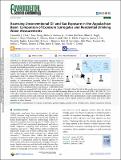Assessing Unconventional Oil and Gas Exposure in the Appalachian Basin: Comparison of Exposure Surrogates and Residential Drinking Water Measurements
Author(s)
Clark, Cassandra J; Xiong, Boya; Soriano, Mario A; Gutchess, Kristina; Siegel, Helen G; Ryan, Emma C; Johnson, Nicholaus P; Cassell, Kelsie; Elliott, Elise G; Li, Yunpo; Cox, Austin J; Bugher, Nicolette; Glist, Lukas; Brenneis, Rebecca J; Sorrentino, Keli M; Plano, Julie; Ma, Xiaomei; Warren, Joshua L; Plata, Desiree L; Saiers, James E; Deziel, Nicole C; ... Show more Show less
DownloadPublished version (2.876Mb)
Publisher with Creative Commons License
Publisher with Creative Commons License
Creative Commons Attribution
Terms of use
Metadata
Show full item recordAbstract
Health studies report associations between metrics of residential proximity to unconventional oil and gas (UOG) development and adverse health endpoints. We investigated whether exposure through household groundwater is captured by existing metrics and a newly developed metric incorporating groundwater flow paths. We compared metrics with detection frequencies/concentrations of 64 organic and inorganic UOG-related chemicals/groups in residential groundwater from 255 homes (Pennsylvania n = 94 and Ohio n = 161). Twenty-seven chemicals were detected in ≥20% of water samples at concentrations generally below U.S. Environmental Protection Agency standards. In Pennsylvania, two organic chemicals/groups had reduced odds of detection with increasing distance to the nearest well: 1,2-dichloroethene and benzene (Odds Ratio [OR]: 0.46, 95% confidence interval [CI]: 0.23-0.93) and m- and p-xylene (OR: 0.28, 95% CI: 0.10-0.80); results were consistent across metrics. In Ohio, the odds of detecting toluene increased with increasing distance to the nearest well (OR: 1.48, 95% CI: 1.12-1.95), also consistent across metrics. Correlations between inorganic chemicals and metrics were limited (all |ρ| ≤ 0.28). Limited associations between metrics and chemicals may indicate that UOG-related water contamination occurs rarely/episodically, more complex metrics may be needed to capture drinking water exposure, and/or spatial metrics in health studies may better reflect exposure to other stressors.
Date issued
2022Department
Massachusetts Institute of Technology. Department of Civil and Environmental EngineeringJournal
Environmental Science and Technology
Publisher
American Chemical Society (ACS)
Citation
Clark, Cassandra J, Xiong, Boya, Soriano, Mario A, Gutchess, Kristina, Siegel, Helen G et al. 2022. "Assessing Unconventional Oil and Gas Exposure in the Appalachian Basin: Comparison of Exposure Surrogates and Residential Drinking Water Measurements." Environmental Science and Technology, 56 (2).
Version: Final published version